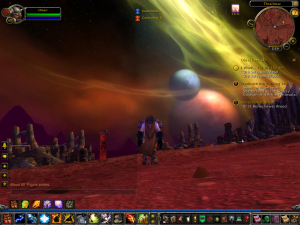WoW: Hacked!
So, here we are at the end of my 6-month subscription. Despite my badmouthing the game in these posts, I’ve basically been thinking for the last few days that my desire to see more of WoW‘s content, including the rest of Outland, was strong enough that I actually would be extending my subscription after all — making this, all told, the most expensive game I’ve played in years — and presumably, in due course, get the remaining expansions. What I do when I hit the level cap, I don’t know. It depends somewhat on whether there’s a new expansion out yet by then, and also on whether it looks like the game’s decline in membership is continuing. (I suppose I’m one of the few people who would be more likely to keep the subscription if it is. I kind of regret not being there at the end of A Tale in the Desert‘s first telling, and being on hand at the fall of another MMO, especially an epochal one like WoW, is not something I’d pass up.) In last night’s session, I even bought some new high-capacity luggage at auction (including a 36-slot fishing box), in expectation of great things to come.
But I started seriously reconsidering when I checked my email this morning. I had a message from Blizzard stating that my account was suspended for three hours, and my password reset, due to abuse of the terms of use. Apparently someone had hacked my account while I was asleep and spammed commercial messages over the chat channels.
That much was demoralizing, but not catastrophic. Blizzard’s abuse team at least understands that one day of spam after six months of good behavior is likely a hack job and doesn’t really hold it against you; the three-hour lockout was as much for my own protection as to keep the chat spam-free. Unfortunately, it seemed to have come too late. When I logged on, Oleari was missing. The only character on her server was a level-1 Human priest.
Oleari, gone? Without her, there wasn’t much point in continuing. I really don’t feel like starting over from scratch (or even from level 27, the highest level of my other characters). The really enraging thing about this wasn’t the loss of wealth and equipment, mind you. I can understand stealing a character’s stuff. I once got hacked and looted in Kingdom of Loathing, but the most valuable things there are unlootable — character experience, permanent skills — and to some extent, the same applies here. Oleari’s an herbalist; she could rebuild her material fortune pretty quickly by selling Outland herbs at auction. (Most of her 1000+ gold was acquired this way in the last two weeks, and that’s after buying a bunch of expensive bags.) But she can only do this if she exists.
No, the enraging thing was that scrapping the character herself seemed so pointless. How did it benefit anyone? It just seemed like a sign that we live in a bad world, where people do bad things to each other for no reason. I actually think I have a better explanation now: it turns out that the hacker created a great many characters on different servers, all Human. Perhaps the spammer deleted Oleari in order to keep within the limit on the number of characters per account.
At any rate, my thoughts were basically that I don’t need to play a game where this sort of thing happens. And so I removed my payment information from the account, giving Blizzard no way to charge me further. But then they impressed me with their responsiveness to my support ticket: despite an estimated 48 hour turnaround (by which point my subscription would have expired), they restored Oleari and all her belongings in just over 12. I can’t think of another online game I’ve played where loss due to hackage has been rectified so swiftly and thoroughly; my usual experience is that what’s done is done and the GMs either can’t or don’t like to undo anything. But WoW is a class act. I suppose the fact that Oleari was simply deleted rather than looted makes it simpler, but still, they deserve some kudos for making wrongfully-deleted characters so easily recoverable.
So, I’m inclined at this point to write this off as just another crucial part of the WoW experience, something that my journeys through Azeroth and Outland would be incomplete without, and keep going. But I was kind of looking forward to putting it behind me and throwing myself into a different game tonight. Maybe I’ll take another break soon. Well, level 70 shouldn’t be that far off.
 Comments(6)
Comments(6)